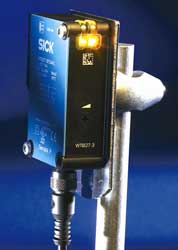
Posted to News on 23rd Jul 2010, 13:29
Pin-Point LED sensors offer similar performance to laser devices
Sick (UK) says its new Pin-Point LED sensor increases the intensity, brightness and accuracy of opto-sensor technology. The Pin-Point, which delivers performance that is claimed to be comparable to that of short-range laser scanners, broadens significantly the range and performance of Sick's LED-based photoelectric switches and photoelectric proximity switches

Based around a new design of LED, the Pin-Point vastly increases light spot intensity and concentrates the energy on a much smaller area. Pin-Point therefore boasts greater functional reserves, improved detection reliability and the capacity to detect objects at longer ranges.
Using Pin-Point technology, Sick photoelectric switches can detect much smaller objects, down to 1mm across, and at distances of up to 500mm, providing an innovative alternative to laser diode photoelectric switches.
Pin-Point technology does not require the same safety regime as is required for lasers, has a wider temperature operating range and, at 100,000 hours, typically lasts twice as long as a laser diode device - all of which results in significant savings both for the machine builder and the end user.
Phil Dyas, a sensor specialist with Sick (UK), comments: "The Pin-Point is an amazing development in the world of opto-sensors - it represents a similar technological leap as the change of transmission light source from light bulb to LED."
How it works
The Pin-Point development has completely reconfigured conventional LED design; by removing the bonding wire at the tip of the LED, the new design avoids the distinctive central black spot in the emitted light, as well as the associated halo of lower-intensity light. The Pin-Point spot has virtually no halo effect and its homogeneous intensity enables a much tighter and precise focus to be achieved.
Alignment with the sensor is simplified because the tighter spot ensures a longer range; furthermore, the more concentrated light helps to overcome in-use problems such as contamination and dirt.
Dyas concludes: "Pin-Point LED design takes the photoelectric and proximity sensor into a precision detection role. It also gives us scope for reducing the number of sensors needed for an application, increasing the potential applications for LED sources."
Follow the link for more information about Sick's Pin-Point LED photoelectric and proximity switches or contact Ann Attridge or Andrea Hornby by telephoning +44 (0)1727 831121 or emailing [email protected] or [email protected], respectively.






























